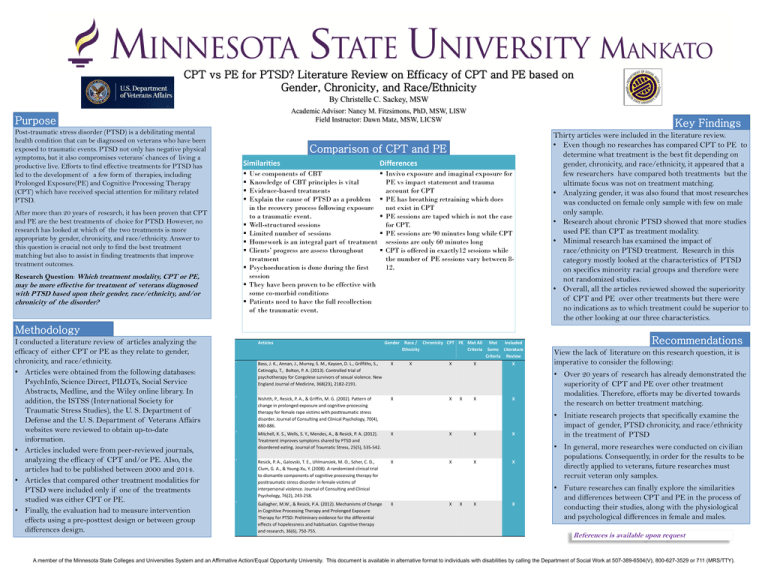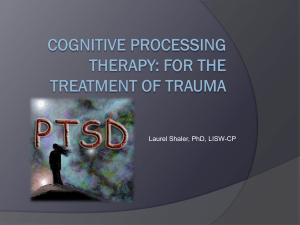Comparing Cognitive Processing Therapy and Prolonged Exposure
advertisement

CPT vs PE for PTSD? Literature Review on Efficacy of CPT and PE based on Gender, Chronicity, and Race/Ethnicity By Christelle C. Sackey, MSW Academic Advisor: Nancy M. Fitzsimons, PhD, MSW, LISW Field Instructor: Dawn Matz, MSW, LICSW Purpose Post-traumatic stress disorder (PTSD) is a debilitating mental health condition that can be diagnosed on veterans who have been exposed to traumatic events. PTSD not only has negative physical symptoms, but it also compromises veterans’ chances of living a productive live. Efforts to find effective treatments for PTSD has led to the development of a few form of therapies, including Prolonged Exposure(PE) and Cognitive Processing Therapy (CPT) which have received special attention for military related PTSD. Similarities After more than 20 years of research, it has been proven that CPT and PE are the best treatments of choice for PTSD. However, no research has looked at which of the two treatments is more appropriate by gender, chronicity, and race/ethnicity. Answer to this question is crucial not only to find the best treatment matching but also to assist in finding treatments that improve treatment outcomes. Key Findings Comparison of CPT and PE Research Question: Which treatment modality, CPT or PE, may be more effective for treatment of veterans diagnosed with PTSD based upon their gender, race/ethnicity, and/or chronicity of the disorder? Differences Use components of CBT Knowledge of CBT principles is vital Evidence-based treatments Explain the cause of PTSD as a problem in the recovery process following exposure to a traumatic event. Well-structured sessions Limited number of sessions Homework is an integral part of treatment Clients’ progress are assess throughout treatment Psychoeducation is done during the first session They have been proven to be effective with some co-morbid conditions Patients need to have the full recollection of the traumatic event. Invivo exposure and imaginal exposure for PE vs impact statement and trauma account for CPT PE has breathing retraining which does not exist in CPT PE sessions are taped which is not the case for CPT. PE sessions are 90 minutes long while CPT sessions are only 60 minutes long CPT is offered in exactly12 sessions while the number of PE sessions vary between 812. Methodology I conducted a literature review of articles analyzing the efficacy of either CPT or PE as they relate to gender, chronicity, and race/ethnicity. • Articles were obtained from the following databases: PsychInfo, Science Direct, PILOTs, Social Service Abstracts, Medline, and the Wiley online library. In addition, the ISTSS (International Society for Traumatic Stress Studies), the U. S. Department of Defense and the U. S. Department of Veterans Affairs websites were reviewed to obtain up-to-date information. • Articles included were from peer-reviewed journals, analyzing the efficacy of CPT and/or PE. Also, the articles had to be published between 2000 and 2014. • Articles that compared other treatment modalities for PTSD were included only if one of the treatments studied was either CPT or PE. • Finally, the evaluation had to measure intervention effects using a pre-posttest design or between group differences design. Articles 1. 2. 3. 4. 5. Gender Race / Chronicity CPT PE Met All Ethnicity Criteria Bass, J. K., Annan, J., Murray, S. M., Kaysen, D. L., Griffiths, S., Cetinoglu, T., Bolton, P. A. (2013). Controlled trial of psychotherapy for Congolese survivors of sexual violence. New England Journal of Medicine, 368(23), 2182-2191. X Nishith, P., Resick, P. A., & Griffin, M. G. (2002). Pattern of change in prolonged exposure and cognitive-processing therapy for female rape victims with posttraumatic stress disorder. Journal of Consulting and Clinical Psychology, 70(4), 880-886. X Mitchell, K. S., Wells, S. Y., Mendes, A., & Resick, P. A. (2012). Treatment improves symptoms shared by PTSD and disordered eating. Journal of Traumatic Stress, 25(5), 535-542. X Resick, P. A., Galovski, T. E., Uhlmansiek, M. O., Scher, C. D., Clum, G. A., & Young-Xu, Y. (2008). A randomized clinical trial to dismantle components of cognitive processing therapy for posttraumatic stress disorder in female victims of interpersonal violence. Journal of Consulting and Clinical Psychology, 76(2), 243-258. X Gallagher, M.W., & Resick, P.A. (2012). Mechanisms of Change in Cognitive Processing Therapy and Prolonged Exposure Therapy for PTSD: Preliminary evidence for the differential effects of hopelessness and habituation. Cognitive therapy and research, 36(6), 750-755. X X X X X X X X X X X X X X Met Included Some Literature Criteria Review X X X Thirty articles were included in the literature review. • Even though no researches has compared CPT to PE to determine what treatment is the best fit depending on gender, chronicity, and race/ethnicity, it appeared that a few researchers have compared both treatments but the ultimate focus was not on treatment matching. • Analyzing gender, it was also found that most researches was conducted on female only sample with few on male only sample. • Research about chronic PTSD showed that more studies used PE than CPT as treatment modality. • Minimal research has examined the impact of race/ethnicity on PTSD treatment. Research in this category mostly looked at the characteristics of PTSD on specifics minority racial groups and therefore were not randomized studies. • Overall, all the articles reviewed showed the superiority of CPT and PE over other treatments but there were no indications as to which treatment could be superior to the other looking at our three characteristics. Recommendations View the lack of literature on this research question, it is imperative to consider the following: • Over 20 years of research has already demonstrated the superiority of CPT and PE over other treatment modalities. Therefore, efforts may be diverted towards the research on better treatment matching. • Initiate research projects that specifically examine the impact of gender, PTSD chronicity, and race/ethnicity in the treatment of PTSD X • In general, more researches were conducted on civilian populations. Consequently, in order for the results to be directly applied to veterans, future researches must recruit veteran only samples. X • Future researches can finally explore the similarities and differences between CPT and PE in the process of conducting their studies, along with the physiological and psychological differences in female and males. References is available upon request A member of the Minnesota State Colleges and Universities System and an Affirmative Action/Equal Opportunity University. This document is available in alternative format to individuals with disabilities by calling the Department of Social Work at 507-389-6504(V), 800-627-3529 or 711 (MRS/TTY).










